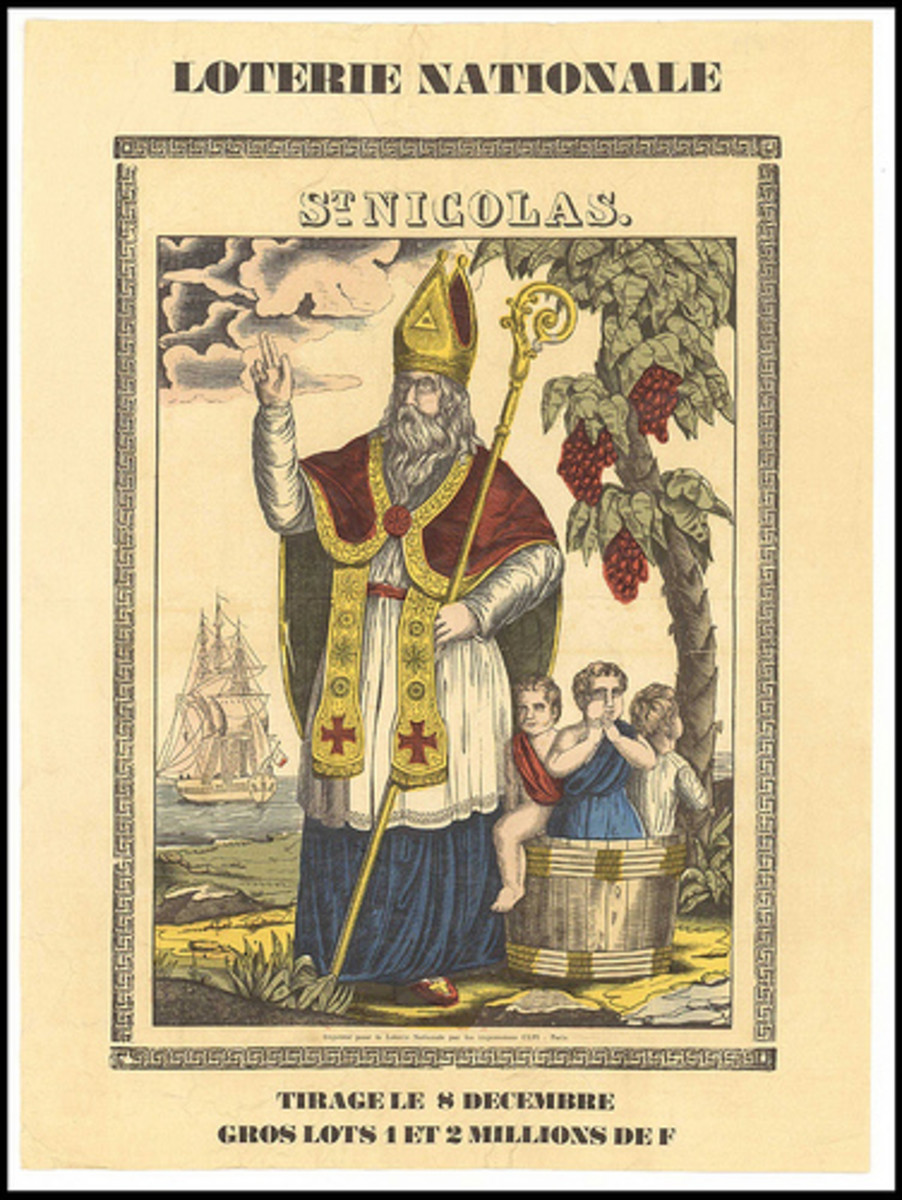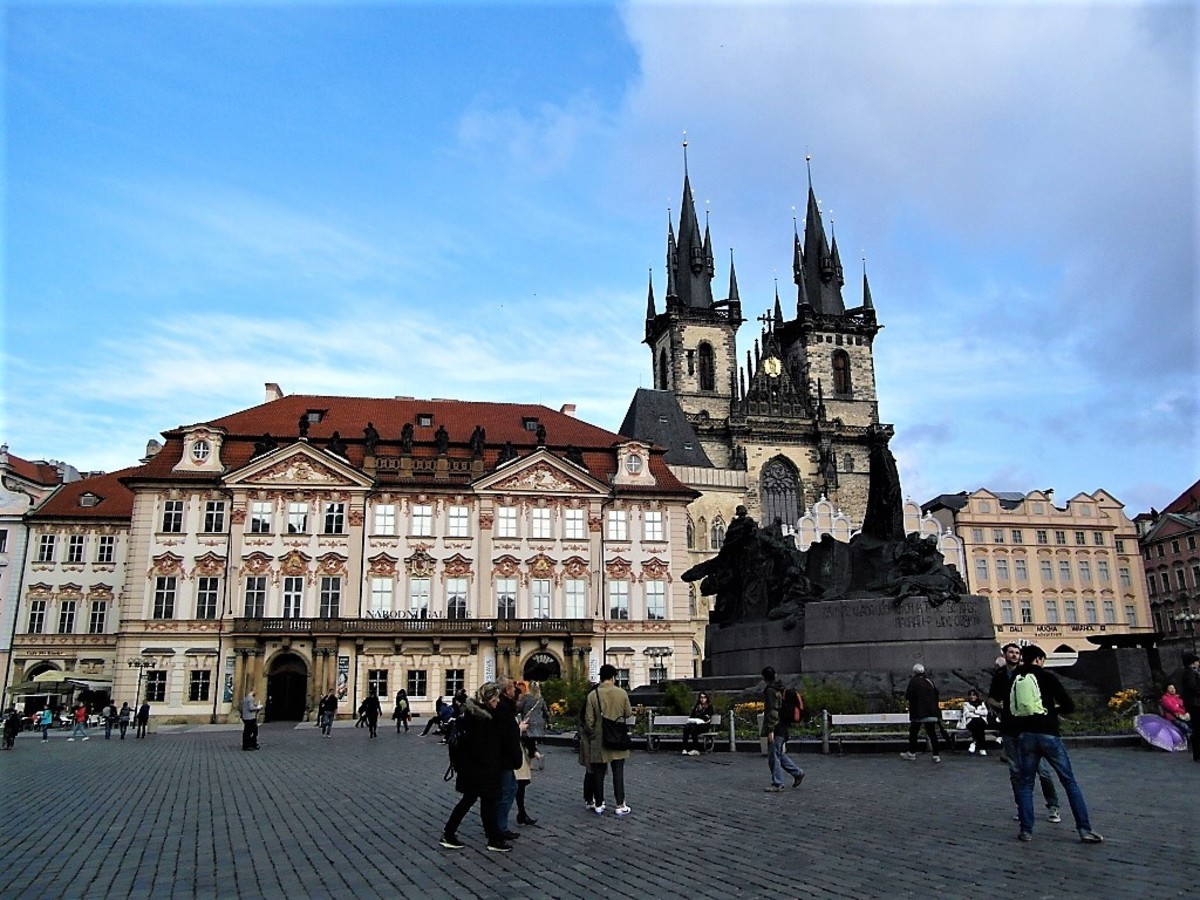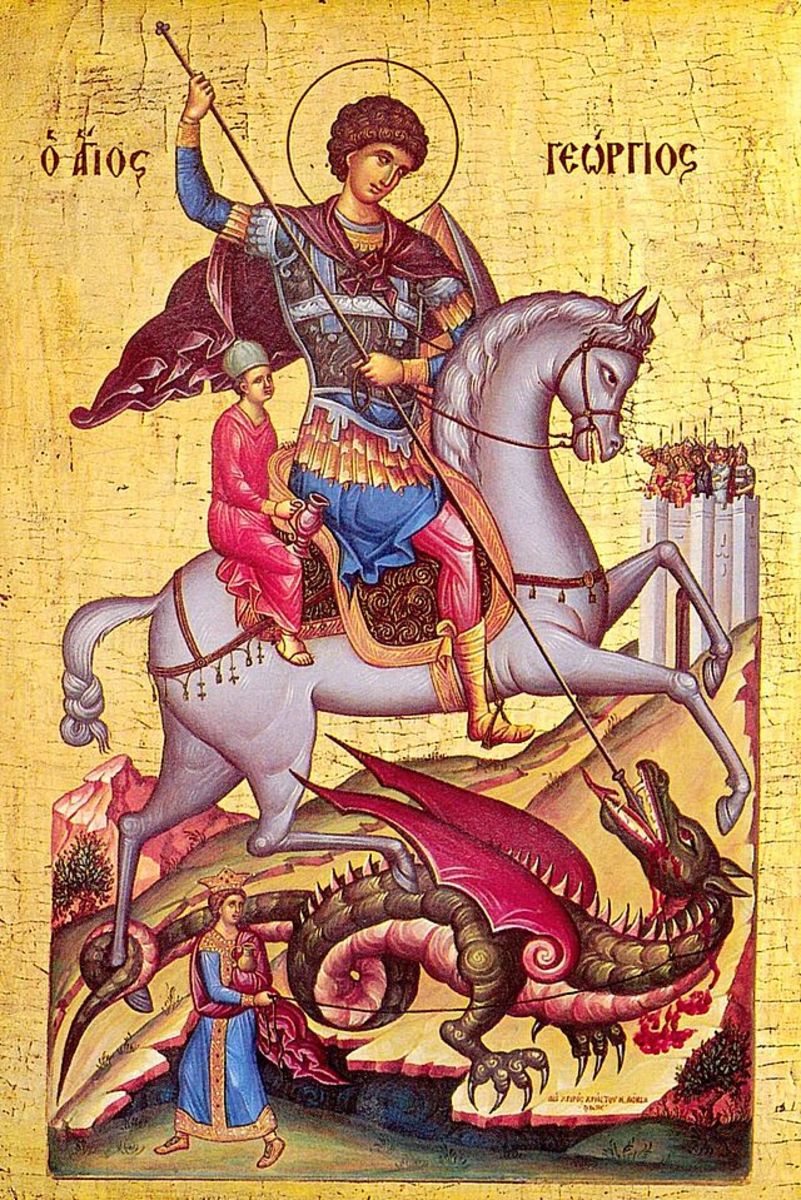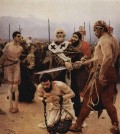St Nicholas - Patron Saint of Many
Patron Saint of Children
As December approaches each year, the name St. Nicholas is encountered with increasing frequency. This is understandable given the Saint's close association with Christmas which falls in December.
The Feast of St. Nicholas, the day set aside by the Church to honor him, falls on December 6th.
Of course, St. Nicholas is best known as the patron saint of children and, for centuries, children in many countries have left their shoes by the door or hung their stockings by the chimney on the night of December 5th in hopes that St. Nicholas would leave them a present.
The tradition in most places is that he only leaves a gift for children who have been good.
In some places he leaves nothing for children who have been bad, and in other places children who have been bad during the year can expect to find a lump of coal or, worse, a birch switch (which their parents can use to administer a spanking for misbehavior) in place of a toy or other gift.
In France and some other neighboring countries, St. Nicholas is accompanied by a rough character named Père Fouettard whose job is to punish children who have misbehaved during the year.
In his role as the patron saint of children, St. Nicholas not only seeks to protect children but also to guide and instruct children, by means of rewards and punishment, in how to grow into kind and loving adults.
The Saint's Connection to the New World Dates back to Christopher Columbus
It was the Dutch who introduced St. Nicholas to the United States through their New Amsterdam colony in what is now New York. St. Nicholas Day was celebrated in the colony just as it had been celebrated in Holland.
When the colony came under English rule in 1674 following the Third Anglo Dutch War, many of the Dutch settlers remained behind in the colony, which was now called New York by the English, however, the Dutch culture remained dominant.
A century and a half later in 1822 the Dutch culture remained strong and St. Nicholas was introduced to the American audience by the publication of Clement Moore's famous poem entitled Twas the Night Before Christmas whose first stanza ended with the lines: The stockings were hung by the chimney with care, In hopes that St Nicholas soon would be there.
While Moore's poem played a major role in introducing St. Nicholas to the United States beyond the borders of the former Dutch colony that was now New York, neither the poem nor the Dutch were the first to introduce the name St. Nicholas to the New World.
Many sources, including the noted historian and Christopher Columbus biographer, Samuel Eliot Morison, that honor belongs to Christopher Columbus himself.
According to Morrison and others, during his first voyage in 1492 after sailing around Cuba, Columbus sailed on to the island of Hispaniola and on the evening of December 5th, the eve of the Feast of St. Nicholas, Columbus found the mouth of a large natural harbor in what is now Haiti, and named the discovery Port Saint Nicholas which, according to Morison, was the first of many places named by Columbus which have retained the original name given by Columbus to this day (see page 278 of Morison's Admiral of the Ocean Sea - A Life of Christopher Columbus).
Christmas Figure and Patron Saint of Children
As December approaches each year, the name St. Nicholas is encountered with increasing frequency. This is understandable given the Saint's close association with Christmas which falls in December. The Feast of St. Nicholas, the day set aside by the Church to honor him, falls on December 6th.
Of course, St. Nicholas is best known as the patron saint of children and, for centuries, children in many countries have left their shoes by the door or hung their stockings by the chimney on the night of December 5th in hopes that St. Nicholas would leave them a present.
The tradition in most places is that he only leaves a gift for children who have been good. In some places he leaves nothing for children who have been bad, and in other places children who have been bad during the year can expect to find a lump of coal or, worse, a birch switch (which their parents can use to administer a spanking for misbehavior) in place of a toy or other gift.
In France and some other neighboring countries, St. Nicholas is accompanied by a rough character named Père Fouettard whose job is to punish children who have misbehaved during the year. In his role as the patron saint of children, St. Nicholas not only seeks to protect children but also to guide and instruct children, by means of rewards and punishment, in how to grow into good adults.
Even the Internet has a Patron Saint - but it is Not St. Nicholas
Given that St. Nicholas is both the patron saint of children and whose feast day is celebrated a little over two weeks before Christmas, it is not surprising that over the years he has become closely associated with Christmas.
However, in addition to children, St. Nicholas is also the patron saint of numerous other groups, organizations and places (nations and cities) to say nothing of thousands of churches throughout the world.
Visit the St. Nicholas Center website, which, in my opinion, is the best St. Nicholas site on the web, and click on the people link and you will see a list of 52 classes of people who claim St. Nicholas as their patron saint.
Throughout the history of Christianity, the faithful have looked upon the saints as examples to be followed in this life. Many have, and still do, call upon the saints in Heaven to intercede for them with God - these people don't pray to the saints so much as ask them deliver their prayers and petitions to God on the believer's behalf.
Knowing that the saints had once lived on this earth and struggled with life's challenges makes it easy for people to relate to them as one human being to another. In addition to asking saints to intercede with God on their behalf, many people throughout Christian history have also adopted one or more saints as their patron and look to these patrons both for inspiration and guidance in leading a good life as well as looking to the saint for protection and help in their lives. When people appealed to a saint for help with a problem and the problem was solved they thanked the saint and spread the word about what had happened.
As a result people with similar problems or interests began to look upon that saint as their patron. Now days, in the Catholic Church, the Vatican has established procedures and processes in place for both determining who should be deemed a saint and for assigning patron saints to particular groups.
This is how a few years ago St. Isidore of Seville (born about 560 AD) came to be assigned the task of being the Patron Saint of the Internet (as well as patron saint of related areas of computers, computer users and computer programmers).
However, in the early days of the Church things were more democratic and informal as Christians simply began referring to deceased holy people as saints and groups and professions simply adopted various saints as their patrons. This is how Nicholas of Myra came to be considered a saint as well as ending up being the patron of numerous groups and professions which include, among others, being the patron saint of children, brides, merchants, grooms, pawn brokers, thieves, bankers, students, orphans, captives, lawyers, lovers, businessmen, embalmers and sailors to name but a few.
St. Nicholas is the Patron of Many Because He Helped Many
Most people have heard the story of how Nicholas as a wealthy young man secretly provided dowries for the three daughters of a merchant who was down on his luck financially.
Without a dowry, women in those days could not expect to marry which not only meant having to remain single but, according to some authorities on the subject, would probably have had to turn to prostitution to support themselves as that was one of the few avenues open to women who lacked a husband or family fortune for financial support.
In the story, Nicholas provided a bag of gold coins for each daughter's dowry by secretly delivering it through an open window or by dropping it down the chimney of the family home.
This kind act became the basis for St. Nicholas becoming the patron saint of brides (and probably why he became the patron saint of grooms as well since they were the recipients of dowries).
Since it was the daughters of a merchant that he helped, Nicholas became the patron saint first of merchants and then of all businessmen. Being a rich man who dispensed money, it was only logical that St. Nicholas came to be the patron saint of first pawnbrokers and their later, bankers, two professions that dealt with money as their product.
In my Hub entitled Father Christmas and His Assistant Père Fouettard, I mentioned the fact that some have speculated that Père Fouettard may represent the cruel butcher in the tale of the three boys who got lost and sought food and shelter from a butcher who invited them into his shop and then not only murdered them but cut their bodies up and preserved them in brine along with a pig he had slaughtered and butchered to sell.
St. Nicholas then came to the shop and not only chastised the butcher but also restored the three boys to life. The encounter with St. Nicholas caused the butcher to turn his life around and repent of his evil past. With this act, St. Nicholas came to be considered the patron saint of young children as well as of butchers.
In another version of the story, the three boys are described as three students and, from this version of the story, St. Nicholas came to be the patron saint of students.
Then there is the story of the two thieves where, after his death, Nicholas appeared before two thieves and his reprimand caused them to repent and turn away from their lives of crime.
There are other similar stories of St. Nicholas appearing before other thieves, robbers, prostitutes and even murderers and it is these associations that have caused him to be adopted as the patron saint of these undesirable professions.
However, unlike brides, merchants, sailors and other law abiding groups, the role of St. Nicholas as the patron saint of such criminals is not that of a protector of the profession but, rather his role is one of confronting these criminals and convincing them to change their ways and lead good lives.
Instead of being the patron and protector of criminals with that group his role is one of trying to eradicate the profession by convincing the members to turn their lives around and become holy like himself. As we approach St. Nicholas Day and the Christmas Season it is good take a moment to reflect on a man who in fact and fantasy has become a major player in the season and whose life an legend embodies the true spirit of Christ and the Christmas Season.
Click the Links Below for More About St. Nicholas & St. Nicholas Day
- St Nicholas Day
December 6th, is St. Nicholas Day, the day designated by the Catholic Church in its Calendar of Saints to honor the man named Nicholas who was Bishop of Myra, which is now a part of Turkey, and noted for his... - Father Christmas and His Assistant Père Fouettard
Saint Nicholas Day is December 6th. In many parts of the world this day is celebrated with St. Nicholas visiting cities and homes where he distributes gifts to children. This tradition goes back to the Middle... - St Nicholas and the Merchant's Daughters
St. Nicholas, who morphed into Santa Claus, was a real historical figure but much of what is known about his is mainly legend. St. Nicholas was a famous bishop in the early days of Christianity and he was... - St Nicholas and the Two Thieves
Even after his death, St. Nicholas continued to watch over and help his flock on earth. This is a story about how the good saint steered two young thieves away from a life of crime. Because of this act, St.... - How to Celebrate St. Nicholas Day
Children love surprises and love Christmas. One tradition that is fun to celebrate with young children is St. Nicholas Day. St. Nicholas was the forerunner of Santa Claus and, like Santa Claus, secretly...
This content is accurate and true to the best of the author’s knowledge and is not meant to substitute for formal and individualized advice from a qualified professional.
© 2008 Chuck Nugent







